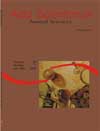<b>Nitrogen balance and endogenous losses in cattle and buffaloes fed with increasing levels of concentrate</b> - DOI: 10.4025/actascianimsci.v29i4.1012
Abstract
The work aimed to evaluate the concentrations of plasmatic and urine urea, the balance of nitrogen compounds, and to estimate the protein requirements for maintenance. Equations recommended by the American and British systems were used in four bovine and four bubaline steers, with initial average weight of 461.19 ± 7.59 and 455.44 ± 7.85 kg for cattle and buffaloes, respectively, distributed into two 4 x 4 Latin squares. The treatments consisted of different levels of concentrate (0.0; 24.0; 48.0; and 72.0%) composed of cracked corn, soybean meal, mineral salt, and Tifton-grass hay. Each period lasted 21 days, being 14 for adaptation and seven for collection. Samples of feces and urine (spot) were taken to estimate the production of fecal dry matter and urine volume. Interactions were observed between the species for N intake (NC), urine-N (UN) g kg-0.75 and urinary urea (UU); no interactions occurred for fecal-N (NF), absorbed-N (NABS), UN (g d-1), balance of N (BN) and plasmatic urea (UP). Regardless of the difference observed between the species, the response variables increased linearly as functions of the growing levels of concentrate that resulted in positive BN. The estimate of metabolizable protein maintenance requirements for cattle and buffaloes differs between the American and British systems.Downloads
Download data is not yet available.
Published
2008-03-06
How to Cite
Pereira, K. P., Véras, A. S. C., Ferreira, M. de A., Batista, Ângela M. V., Marques, K. A., & Fotius, A. C. A. (2008). <b>Nitrogen balance and endogenous losses in cattle and buffaloes fed with increasing levels of concentrate</b> - DOI: 10.4025/actascianimsci.v29i4.1012. Acta Scientiarum. Animal Sciences, 29(4), 433-440. https://doi.org/10.4025/actascianimsci.v29i4.1012
Issue
Section
Ruminant Nutrition
DECLARATION OF ORIGINALITY AND COPYRIGHTS
- I Declare that current article is original and has not been submitted for publication, in part or in whole, to any other national or international journal.
The copyrights belong exclusively to the authors. Published content is licensed under Creative Commons Attribution 4.0 (CC BY 4.0) guidelines, which allows sharing (copy and distribution of the material in any medium or format) and adaptation (remix, transform, and build upon the material) for any purpose, even commercially, under the terms of attribution.
Read this link for further information on how to use CC BY 4.0 properly.
0.9
2019CiteScore
29th percentile
Powered by 








































